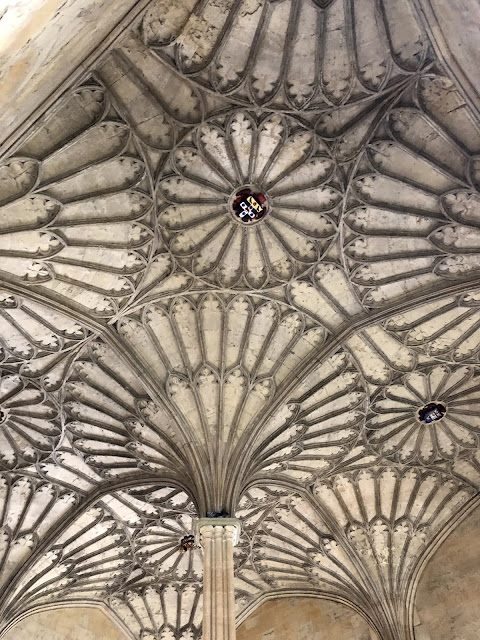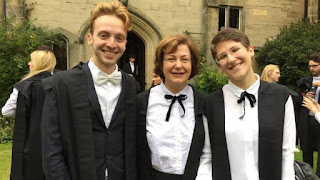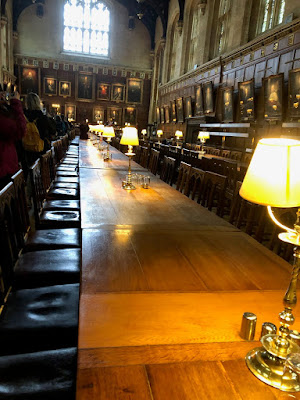Part of the problem I see in keeping a blog for this 3 week Study Abroad trip is that we do so much that I don't have time to reflect a great deal, nor just sit and find pictures and write. So, today I am writing about our trip to Oxford and only focusing on the Oxford University part.
Our first trip on a train together went smoothly. As always, I brought %&*$ snacks for the @#$%& train and everyone was very happy--although sleepy as we left early. We arrived and found our way to our guide, William Underhill. William, it turns out, was a reporter for the London Office of Newsweek and was a wonderful guide. The students paid excellent attention to the information he had to share. It was a dreary, rainy day...all day...and we traipsed in and out of rain and through puddles and were sodden at the end of the tour but all stayed attentive and soldiered on.
Oxford University is the oldest existing university in the English speaking world. Its origins can be traced back as far as 1096!!! That is only 30 years after the Battle of Hastings.(I have no idea, how I remember that! Thanks Mr. Lowman.) OX took its first International student in 1190.
It appears there is a long history of "town and gown" mentality as Oxford has a history of riots and serious attacks when the world of students and community members clashed. After the first riots, medieval halls were created for student residences and one of those first endowed houses was Merton College--it still exists today and was one that we were able to tour.
It took 600 years before women were admitted in 1878 to all women colleges and in 1978 women were allowed entry into the all-male colleges. However, women were not granted degrees until 1920. "Yes, you can come to school and learn, but there will be no record of it!"
Also, just to get a sense of what a typical week is like at Oxford, see this excerpt taken from the Oxford website:
During the first year, you will be expected to attend around five lectures each week, participate in regular meetings with tutors to discuss work, conduct independent research and write at least one essay a week. In the second and third years you will have the opportunity to choose from an enormous variety of lectures, and your regular tutorials will be supplemented by faculty classes where you will discuss work with a larger number of students. The third-year thesis will give you the opportunity to engage in a piece of independent research. Generally students are very much in charge of their own timetable throughout their course.
Tutorials are usually 2-4 students and a tutor. Class sizes may vary depending on the options you choose. There would usually be no more than around 12 students although the more popular classes may include up to 30 students. Most tutorials, classes, and lectures are delivered by staff who are tutors in their subject. Many are world-leading experts with years of experience in teaching and research. Some teaching may also be delivered by postgraduate students who are usually studying at doctorate level.
In the 1200's unrest between the town and gown grew so bad that some students ended up leaving Oxford for Cambridge and hence, the creation of Oxford's to this day's serious rival Cambridge University.
There are 38 colleges at Oxford.Our first stop was at the most popular of the colleges. Christ Church. Not only because it is very beautiful but it is the site of many Harry Potter movie moments and the banquet hall was used as a template for the Hogwarts one.
Students wear traditional academic gowns with white shirts, called sub fusc (It was just in the 80's females were allowed to wear trousers.),for exams, formal meals and other formal events. Terms are shorter than an American University term and once the end nears, students sit for exams. On the 3 days of exams, they are wearing their gowns and wear a white carnation that signifies it is exam time for them. On the second day it is a slight pink carnation and on the last day a red carnation is seen. This goes back to the days of inkwells and students would drop their flower in their ink well while they sat at desks and it would absorb the ink...by the 3rd day it would be red. When the exams are completed, much happiness ensues. Students then "trash" each other with confetti, silly string, shaving cream and more. We saw several students who were trashed but I didn't get their picture, so here is an example from the Oxford site.
So, enough with words, enjoy the pictures:
 |
Ceiling of the Christ Church Chapel |
 |
| Hand carved an amazing this chapel front and back |
 |
| Radcliffe Camera--one of the most iconic symbols of Oxford: Almost always seen in an Inspector Morse or Endeavour episode. |
 |
| Crazy little gate that only 1 person can go through at a time. |
 |
| Original Latin at the Bodleian Library |
 |
| Entrance to the College Dinner Hall |
 |
| Brasenose College Entrance I love this little cake shop at Oxford and wanted the students to see the great workmanship. You can watch the women work on the designs. |
Exeter College
 |
| Trinity College |
 |
| Trinity College--there goes my students |
 |
| Bridge of Sighs |


The annual boat race is a contest that began as a competition between Oxford and Cambridge (1829). Each college puts up several teams and they all line up on the tiny, narrow Thames (or Isis as they call it) river. As only Oxford can do, because there are many boats and the river is very narrow, so to decide who goes first, they simply ram into each other and whoever gets to the end wins. The only graffiti allowed at Oxford is when a team wins...like below.


You can read more about the Boat Race here
























No comments:
Post a Comment